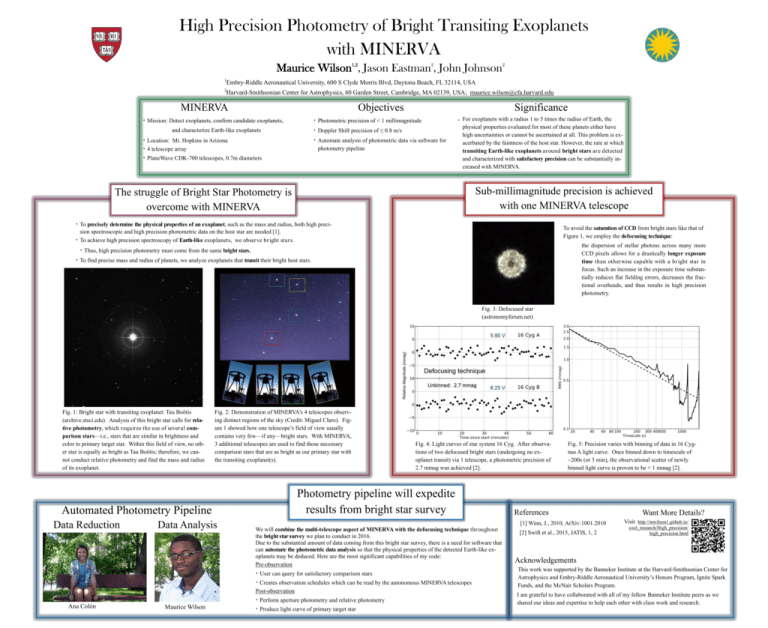Photometry pipeline will expedite results from bright star survey
advertisement

High Precision Photometry of Bright Transiting Exoplanets with MINERVA 1,2 2 2 Maurice Wilson , Jason Eastman , John Johnson 1 Embry-Riddle Aeronautical University, 600 S Clyde Morris Blvd, Daytona Beach, FL 32114, USA 2 Harvard-Smithsonian Center for Astrophysics, 60 Garden Street, Cambridge, MA 02139, USA; maurice.wilson@cfa.harvard.edu MINERVA Objectives · Mission: Detect exoplanets, confirm candidate exoplanets, Significance · Photometric precision of < 1 millimagnitude · Doppler Shift precision of ≤ 0.8 m/s · Automate analysis of photometric data via software for and characterize Earth-like exoplanets · Location: Mt. Hopkins in Arizona · 4 telescope array · PlaneWave CDK-700 telescopes, 0.7m diameters photometry pipeline For exoplanets with a radius 1 to 5 times the radius of Earth, the physical properties evaluated for most of these planets either have high uncertainties or cannot be ascertained at all. This problem is exacerbated by the faintness of the host star. However, the rate at which transiting Earth-like exoplanets around bright stars are detected and characterized with satisfactory precision can be substantially increased with MINERVA. Sub-millimagnitude precision is achieved with one MINERVA telescope The struggle of Bright Star Photometry is overcome with MINERVA · To precisely determine the physical properties of an exoplanet, such as the mass and radius, both high preci- To avoid the saturation of CCD from bright stars like that of Figure 1, we employ the defocusing technique: sion spectroscopic and high precision photometric data on the host star are needed [1]. · To achieve high precision spectroscopy of Earth-like exoplanets, we obser ve br ight star s. the dispersion of stellar photons across many more CCD pixels allows for a drastically longer exposure time than other wise capable with a br ight star in focus. Such an increase in the exposure time substantially reduces flat fielding errors, decreases the fractional overheads, and thus results in high precision photometry. · Thus, high precision photometry must come from the same bright stars. · To find precise mass and radius of planets, we analyze exoplanets that transit their bright host stars. Fig. 3: Defocused star (astronomyforum.net) Fig. 1: Bright star with transiting exoplanet: Tau Boötis (archive.stsci.edu). Analysis of this bright star calls for relative photometry, which requires the use of sever al comparison stars—i.e., stars that are similar in brightness and color to primary target star. Within this field of view, no other star is equally as bright as Tau Boötis; therefore, we cannot conduct relative photometry and find the mass and radius of its exoplanet. Fig. 2: Demonstration of MINERVA’s 4 telescopes observing distinct regions of the sky (Credit: Miguel Claro). Figure 1 showed how one telescope’s field of view usually contains very few—if any—bright stars. With MINERVA, 3 additional telescopes are used to find those necessary comparison stars that are as bright as our primary star with the transiting exoplanet(s). Photometry pipeline will expedite results from bright star survey Automated Photometry Pipeline Data Reduction Data Analysis Fig. 4: Light curves of star system 16 Cyg. After observations of two defocused bright stars (undergoing no exoplanet transit) via 1 telescope, a photometric precision of 2.7 mmag was achieved [2]. We will combine the multi-telescope aspect of MINERVA with the defocusing technique throughout the bright star survey we plan to conduct in 2016. Due to the substantial amount of data coming from this bright star survey, there is a need for software that can automate the photometric data analysis so that the physical properties of the detected Earth-like exoplanets may be deduced. Here are the most significant capabilities of my code: Pre-observation · User can query for satisfactory comparison stars · Creates observation schedules which can be read by the autonomous MINERVA telescopes Post-observation Ana Colón Maurice Wilson · Perform aperture photometry and relative photometry · Produce light curve of primary target star Fig. 5: Precision varies with binning of data in 16 Cygnus A light curve. Once binned down to timescale of ~200s (or 3 min), the observational scatter of newly binned light curve is proven to be < 1 mmag [2]. References [1] Winn, J., 2010, ArXiv:1001.2010 [2] Swift et al., 2015, JATIS, 1, 2 Want More Details? Visit http://mwilson1.github.io/ cool_research/High_precision/ high_precision.html Acknowledgements This work was supported by the Banneker Institute at the Harvard-Smithsonian Center for Astrophysics and Embry-Riddle Aeronautical University’s Honors Program, Ignite Spark Funds, and the McNair Scholars Program. I am grateful to have collaborated with all of my fellow Banneker Institute peers as we shared our ideas and expertise to help each other with class work and research.








